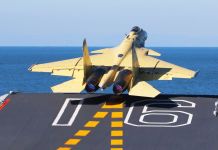China’s promotion of its cutting-edge fighter jets, including the J-10C and J-35, in international markets has already attracted significant attention. Now, Beijing is pushing its commercial aircraft, posing a direct competition to Boeing and Airbus.
The Commercial Aircraft Corporation of China (COMAC) is poised to make a debut at the Dubai Air Show in November 2025 with its small C909 and narrow-body C919 aircraft. The display of these two aircraft, which are widely operated in China, is aimed at attracting buyers in the affluent Middle East.
In the past, China has displayed its weapon systems in the Middle East as countries look to diversify their arms purchases amid global uncertainties. China debuted its J-10C at the Dubai Air Show in November 2023.
It also displayed the FC-31 stealth fighter jet, the Y-20 strategic transport aircraft, the Z-20 tactical utility helicopter, and unmanned aerial vehicles (UAVs), including the AR-36 vertical takeoff and landing drone and the Wing Loong-X and Wing Loong-2 fixed-wing drones.
More recently, in February 2025, the International Defence Exhibition in Abu Dhabi (IDEX), China Aerospace Technology and Industry Corporation (CATIC) showcased the J-35, a carrier-based stealth fighter, as well as the J-10CE.
China has been especially pushing the J-10C for export to the Middle East, particularly to Egypt. Some reports have indicated that Iran has also shown interest in the aircraft.
While China has yet to export a combat aircraft to a Middle Eastern country, it has already begun trying its luck with commercial aircraft. The Shanghai-based state-owned aircraft manufacturer, Comac, is listed among the 1,500 exhibitors at the show, which runs from November 17 to 21.
It will have the opportunity to interact with almost 148,000 people at the air show and market its most popular passenger aircraft.
According to reports, China is leveraging the growth in trade ties with the Middle East through the Belt and Road Initiative (BRI) to pitch the aircraft. According to a July report by the Griffith Asia Institute in Australia, Beijing’s 12-year-old Belt and Road Initiative (BRI), which aims to build trade-linked infrastructure abroad, generated US$19.4 billion in construction engagement in the Middle East in the first half of this year.
Can Comac Compete With Boeing & Airbus
China is debuting two of its commercial aircraft: the C909 and the C919.
The COMAC C909, which was formerly known as the ARJ21, is China’s first indigenously developed regional turbofan airliner.
It represents a key step in China’s push for aviation self-reliance. The aircraft received its Type Certificate from the Civil Aviation Administration of China (CAAC) in December 2014 and Production Certificate in July 2017, entering commercial service in June 2016 with launch operator Chengdu Airlines.
While Chinese aircraft rely on several Western parts, COMAC benefits from China’s strong industrial capabilities, capacity, and financial backing.
Boeing and Airbus have long held a dominant position in the commercial aircraft market. Meanwhile, the market leaders in regional jets have historically been Bombardier of Canada and Embraer of Brazil. However, China’s entry into the market is likely to intensify competition.

The C909 is designed for short- to medium-haul routes and competes with aircraft such as the Bombardier CRJ series, Embraer E-Jets, and Airbus A220. Its rear-mounted engines provide operational advantages on unpaved runways common in regional networks.
Indonesia’s TransNusa, Lao Airlines, and Vietnam’s VietJet collectively operate seven C909 aircraft. Additionally, Air Cambodia could place the largest-ever overseas order for C909 passenger jets after it signed a Memorandum of Understanding (MoU) for 10 jets, with the option to purchase 10 more.
Meanwhile, the C919 narrowbody jet, which China has positioned as a competitor to Boeing’s 737 MAX and Airbus’s A320neo, is particularly popular among domestic airlines.
The C919 single-aisle narrow-body jet has been in service since 2023. China’s “big three” state-owned airlines – Air China, China Southern, and China Eastern are already flying the C919. The C919 reportedly has dimensions similar to those of the Airbus A320, positioning it as a direct competitor.
The program symbolizes Beijing’s ambition to challenge the Airbus-Boeing duopoly, with billions of dollars invested and strong domestic backing from airlines and lessors.

COMAC plans to deliver 25 C919s in 2025, scaling to 75 annually soon after. In contrast, Boeing and Airbus face delays—Boeing due to quality issues and tariffs, and Airbus due to supply chain bottlenecks.
If it fixes its woes, COMAC can emerge as a viable third alternative. However, that would be a herculean task given that China’s jet-building program uses foreign components. This year, COMAC encountered an unforeseen obstacle when the United States temporarily suspended exports of the CFM engines it uses on the C919 from June to July.
COMAC leverages China’s massive domestic demand and offers subsidized financing. It has targeted emerging markets in Southeast Asia and Africa, with early interest from airlines such as Brunei’s GallopAir and potential buyers such as AirAsia. Ryanair’s CEO earlier expressed openness to purchasing the C919 if priced low enough.

Last year, the C919 showcased its capabilities at one of Asia’s most prestigious aviation events held in Singapore. The C919 was described by Brendan Sobie, founder of the Singapore-based aviation consultancy Sobie Aviation, as “kind of like a milestone, and it’s the storyline for the show.”
China has been promoting its civilian airliners in the Southeast Asian Market, where countries are expected to choose a cost-effective aircraft over the more expensive offerings from market leaders.
In 2023, Brunei’s GallopAir ordered 15 C919s (plus 15 regional C909/ARJ21 jets) in a $2 billion deal—the first international C919 commitment. Brunei’s regulator approved CAAC certification in October 2025, paving the way for operations, though deliveries remain pending and could start by year-end.
Malaysia’s AirAsia, a major low-cost carrier, confirmed in September 2025 that it’s in “advanced talks” for an undisclosed number of C919s, potentially making it the first foreign operator.
The C919 holds Chinese CAAC certification but awaits validation from major regulators like the European Union Aviation Safety Agency (EASA) and the Federal Aviation Administration (FAA).
This restricts operations in the US, Europe, and many allied markets, limiting early exports to regions that accept CAAC approval. However, that is not going to stop China from promoting its aircraft to potential buyers in the Middle East.
- Contact the author at sakshi.tiwari13 (at) outlook.com
- Follow EurAsian Times on Google News




